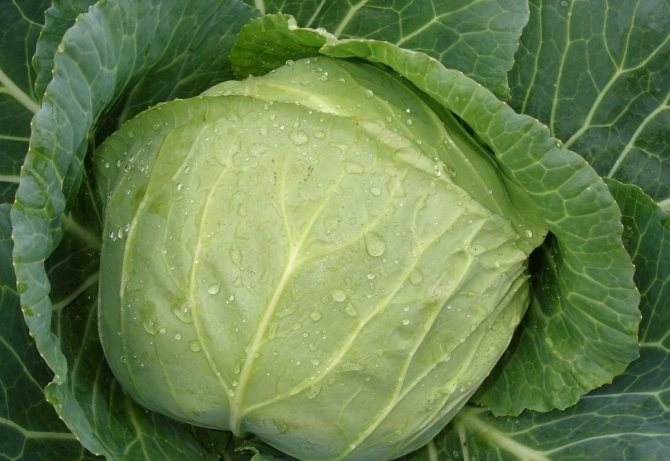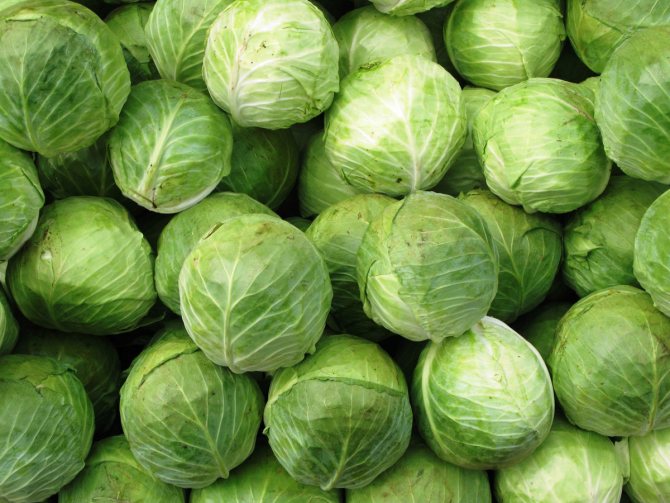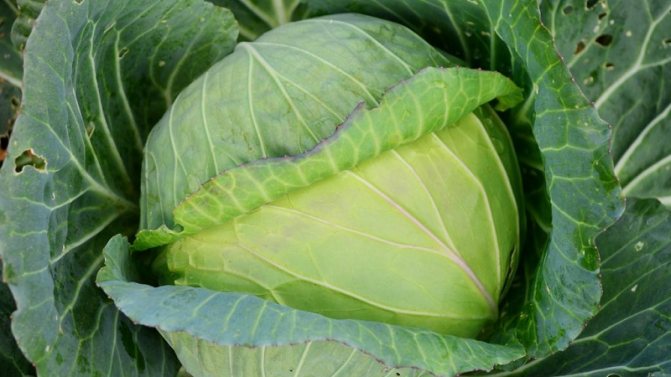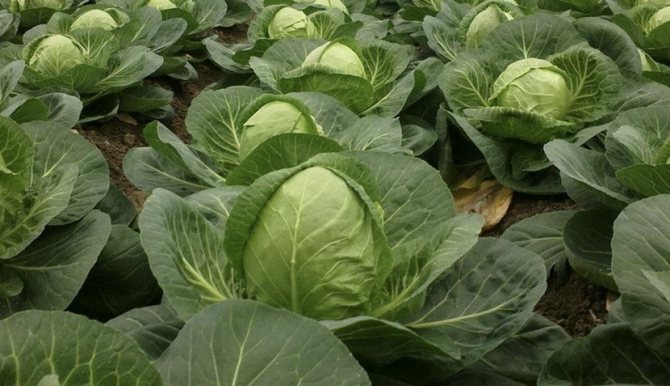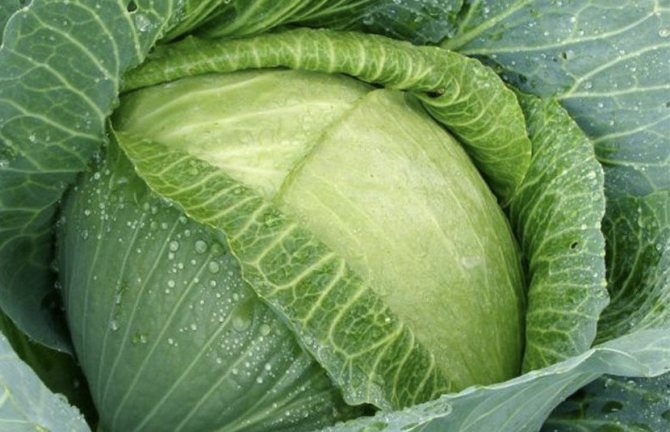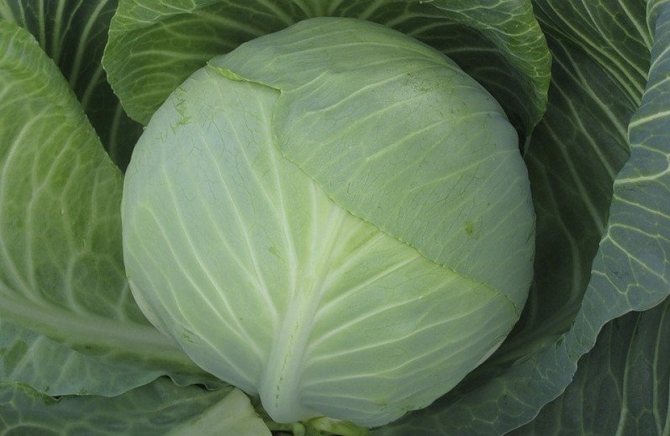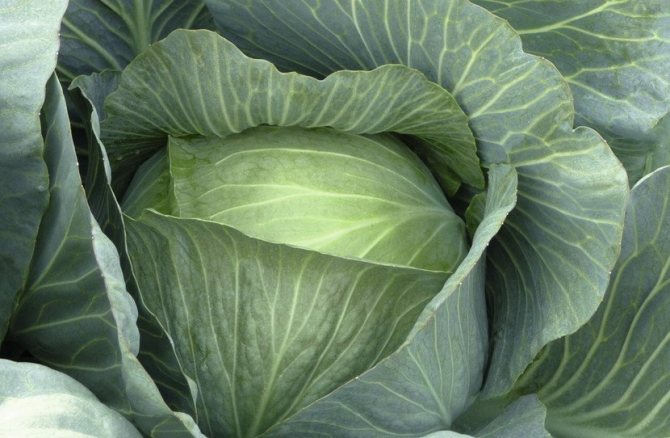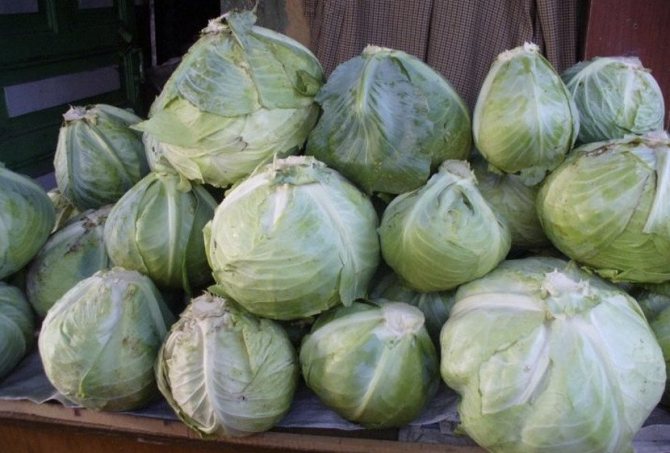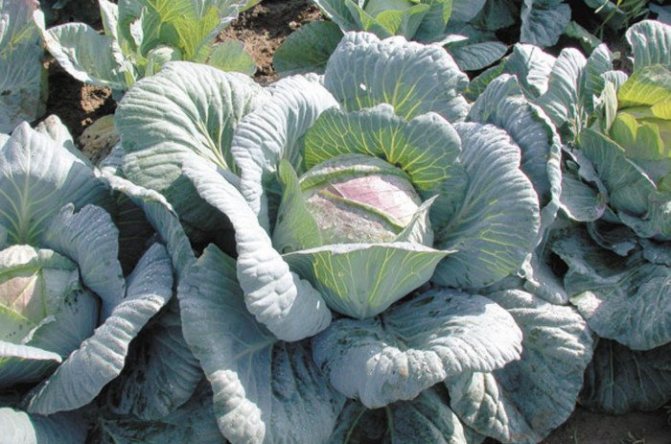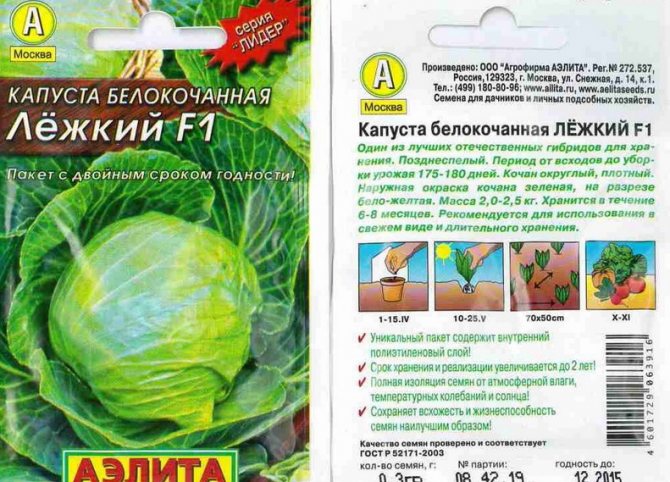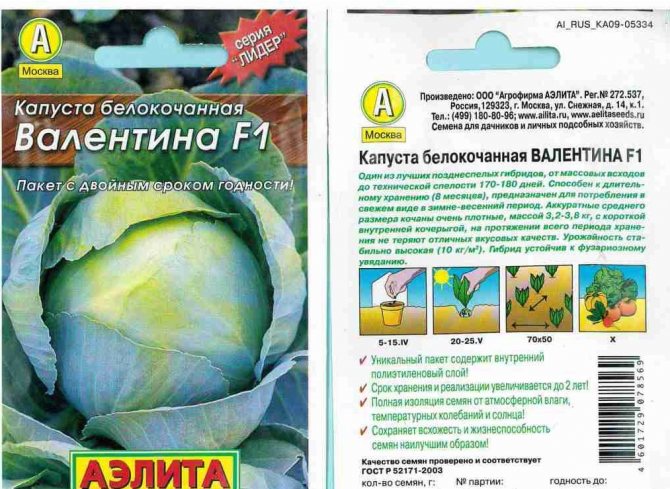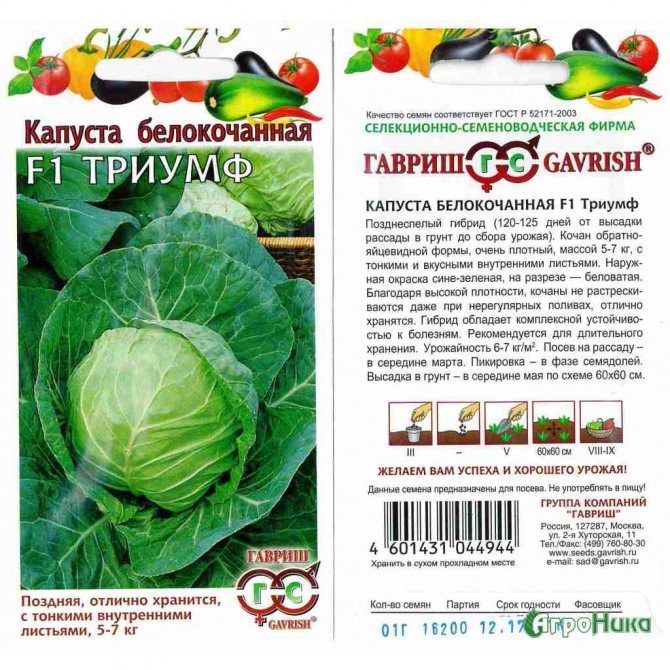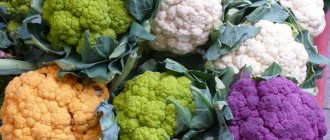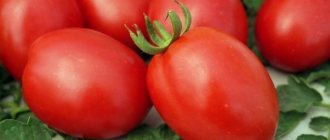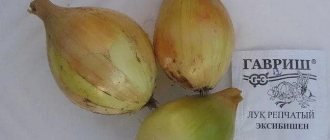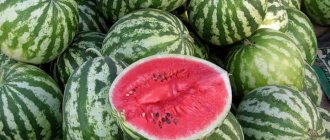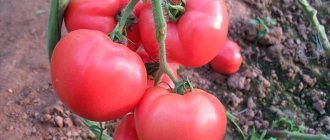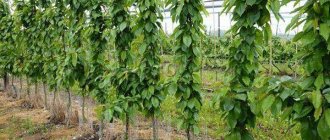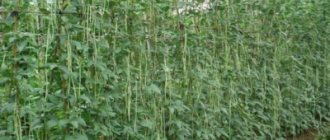White cabbage Snegurochka F1 is a late variety, which means that it is ideal for long-term storage, fermentation and other processing. It should not be confused with Snegurochka cauliflower, although both varieties have common features - beautiful white pulp and great taste.
| Pick-up location | Ripening terms | View | Purpose | Origin | Ripening period | Weight |
| Open ground | Late maturing | White-headed | Fresh, Long-term storage, Salting, Souring, Cooking | Hybrid | 130-170 | 3-5 |
Choosing a variety of white cabbage for planting in 2020
Cabbage is grown using seedlings or in a seedless way, by sowing seeds directly on the garden bed. Before choosing the variety you need for planting, it is advisable to determine for what purposes the culture will be used: for fresh consumption, long-term storage, conservation, fermentation.
Early varieties are grown only for the preparation of light vegetable salads. Mid-season cabbage can be eaten fresh, used for pickling and preservation. Late varieties are mainly used for processing, they are fermented, and you can cook vegetable dishes from them. Early or late cabbage is grown using seedlings. Mid-season - in a seedless way, seeds are sown in the garden in May.
When choosing seeds, you should pay attention to which region this crop is best suited for. Each variety has its own characteristics of cultivation.
Description of late cabbage
Many late varieties have been bred. They differ mainly in the duration of ripening. While early varieties take three months from germination to fully ripen, mid-season varieties may take four months, then some varieties of late cabbage mature only six months after the start of growth from seeds.

Description of late cabbage
This long wait is rewarded:
- equally long shelf life;
- high yield of varieties;
- excellent transportability of heads of cabbage;
- readiness to preserve all valuable substances, taste and textural properties during salting, pickling and fermentation.
By the way! Varieties intended for long-term storage improve their palatability over time. In addition, in cabbage, unlike other vegetables and root vegetables, nitrates do not accumulate during the time it is stored.
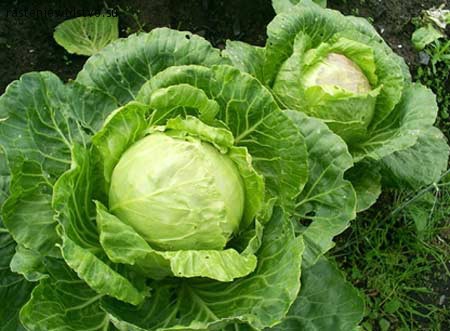

Cabbage
The second difference between different types of cabbage in terms of ripening is agricultural technology. In general terms, it is similar not only for all cabbages, but also for many crucifers. But the timing of sowing, germination, planting and some growth conditions differ in detail in late cabbage from its mid-season and early-maturing "relatives".
By the way! Some varieties of late-ripening cabbage can stay intact, under appropriate conditions, until the next harvest.
Popular early and ultra-early cultures
Early maturing varieties do not differ in high yield rates. This cabbage is grown to be eaten fresh. Leaves of early vegetables are tender, sweetish in taste, not tough. Heads of cabbage are small and loose. Overgrowing, they often crack. The first crop can be harvested 85-125 days after germination. Early cabbage is not resistant to decay, it quickly loses its freshness during storage.
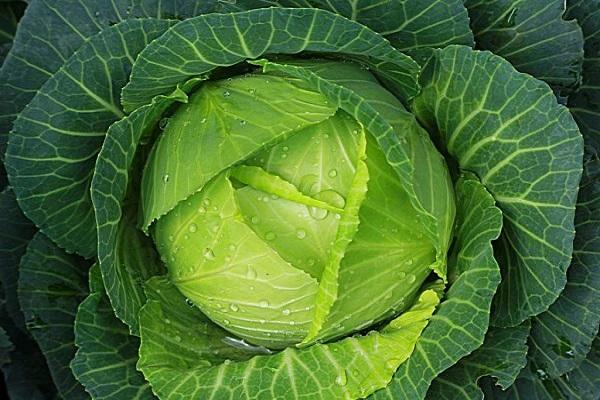

Tobia
Dutch variety, suitable for growing in all regions. Head weight - 5 kilograms. On the cut, the vegetable has a white and slightly yellowish tint. The inner stump is small. The heads are plump, they are not stored for long. The taste is sweetish, without bitterness, the leaves are juicy, thin.
Rinda
Dutch hybrid. The culture is resistant to cracking. Head of cabbage is compact, uniform, plump. Weight - 3-5 kilograms. The inner stalk is very short.
June
Bred in 1967 by Russian breeders. The cabbage rosette has a diameter of 50 centimeters. Heads of cabbage - homogeneous, juicy, tender, weighing up to 3 kilograms. The culture is able to withstand small (up to 2 degrees) frost, is resistant to cracking, and can get sick with keel.
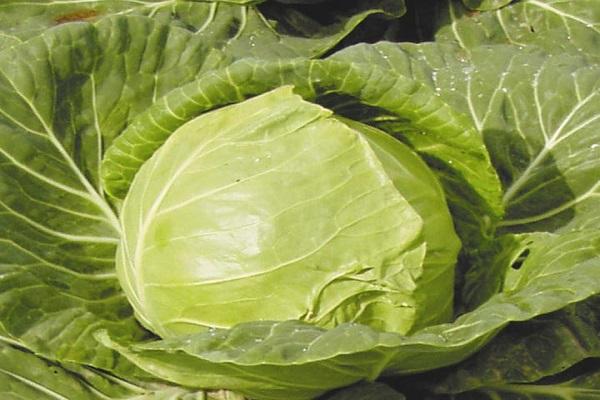

Mid-season varieties
Mid-early cabbage is an intermediate type between early and late. Compared to an early ripening crop, it has a denser head of cabbage. True, the taste is not as delicate as that of early vegetables.
Cabbage ripens 120-130 days after planting. This crop is inferior to late varieties only in terms of storage duration and yield. Cabbage is eaten fresh and used for pickling. It is best to plant several heads of early and medium cabbage. Such a technique will allow you to always receive tender, juicy, fresh vegetables that have not stood in the garden at the table.
Megaton
Dutch hybrid. It can be grown in all regions of Russia, except for the Middle Volga region. The culture has a raised rosette. Ripe vegetables - juicy, crispy, round, dense, smooth. The mass of one copy is 3-4 kilograms. The upper leaves are wrinkled, with a bluish-silvery sheen. The stump located inside is up to 15 centimeters long. Cabbage is very sweet, suitable for salads and pickling.
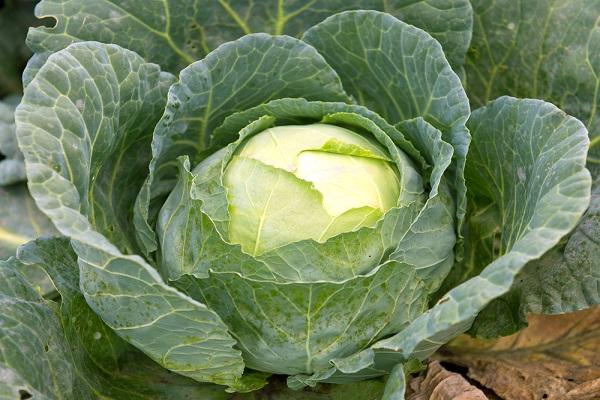

Sugar queen
A hybrid crop that ripens in August. Ripe vegetables are sweet and juicy. Suitable for making stuffed cabbage and pickling. The average weight of one head is about 4 kilograms.
Peking cabbage and ornamental cabbage
Some Siberian summer residents grow Peking cabbage varieties suitable for Siberia.
- Vesnyanka. This early variety ripens 35 days after planting and is ready to withstand light frosts down to -10 ° C.
- Orange tangerine. The vegetative period of this cabbage variety is about 40 days and is considered one of the most productive of the Beijing varieties. This type of Peking cabbage for Siberia produces vegetables weighing up to 1 kg.
Among the decorative varieties, Siberian summer residents have adapted to growing an early ripe high-yielding hybrid Victoria. Its heads weigh up to 2 kg. The unpretentious Victoria variety maintains yields even in cold conditions. Decorative varieties Kudesnitsa and Lenok are slightly less popular.
Best Late Ripening Cabbage
The late-ripening culture is considered the most productive. Such cabbage is safer for health, vegetables accumulate nitrates in their leaves to a lesser extent. Late varieties are salted, cabbage rolls, vegetable stews are prepared from them. Cabbage ripens for a very long time - almost 130-160 days. When stored properly, fresh heads of cabbage can lie until next spring.
Late varieties are characterized by excellent disease and rot resistance. The heads of cabbage are plump, not too sweet, but over time the taste becomes more pleasant. Late can stand in the garden until the very frost.


Aggressor F1
Late Dutch hybrid. The plant is viable, withstands any weather conditions. Cabbage can grow in nutrient-poor soil. Vegetables are grown in all regions of Russia, even in the driest. The mass of a mature head is 3.5-5 kilograms. The heads are round, plump. The upper leaves are dark green, wavy. On a cut, the head of cabbage is white, with a slight yellowness. Mature heads do not crack. The culture rarely gets sick, the real threat is whitefly and aphids.
Moscow late
Popular culture, bred back in 1937. Spreading leaf rosette, almost 1 meter in diameter. The outer leaves are gray-green with a waxy bloom. Ripe heads of cabbage are huge, dense. The mass of one is 4-6 kilograms. The inside of the cabbage is white. Ideal for fermentation. Fresh heads are stored until February.
Mara
Culture bred in Belarus. Cabbage rarely gets sick, almost does not rot. Can be stored until spring. The mass of a head of cabbage is about 4 kilograms. Great for fermentation.
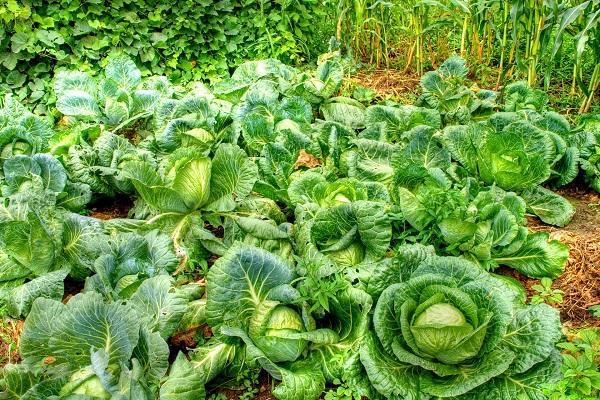

Amager 611
Can be grown in any region. Not afraid of frost. Cabbage rosette is slightly raised, its diameter is up to 80 centimeters. The leaves are smooth, the upper ones are slightly wrinkled. Ripe cabbage has a dense, round head of cabbage. The mass of one is about 4 kilograms. The culture is specially grown for long-term winter storage. The longer the cabbage is stored, the tastier it becomes. Over time, the bitterness disappears, the leaves become soft and juicy.
See also
Why cabbage has purple leaves and what to do and what is missingRead
Languadeaker
Vegetable bred in Germany. Above the cabbage head is gray-green, inside - white. The average weight of one specimen is 3-5 kilograms. Ripe vegetables have a sweet taste. The culture can get sick with keel, tobacco mosaic. Plucked vegetables are stored for a long time, used for pickling.
Sugar Loaf
A late winter-hardy culture bred in Russia. The socket is raised, huge, spreading, up to 0.8 meters in diameter. The upper leaves are large, gray-green, with a waxy coating. Ripe heads of cabbage are plump, crispy, juicy, white in the context. The mass of one is 3.5 kilograms.
Vegetables are best harvested after frost. They become sweeter and tastier. Cabbage is used for fermentation and can be stored until spring. Vegetables immediately after harvesting from the garden are slightly bitter. After a month, the bitterness disappears. Vegetables can be eaten fresh or processed.
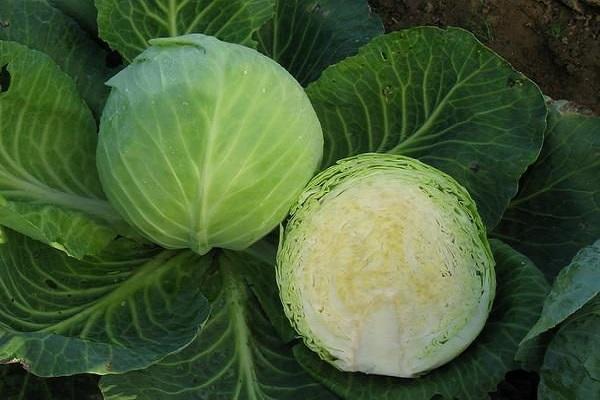

Gingerbread man
A hybrid developed in Russia. The culture is demanding on the soil. Poorly tolerates lack of moisture. The outer leaves are slightly raised. Cabbage has a compact appearance, the diameter of the rosette is about 0.5 meters. The culture is perfectly stored (up to 7 months), has a dense head of cabbage of a delicate yellowish-white color. The mass of one vegetable is up to 4.5 kilograms.
The best varieties and hybrids of cabbage for Siberia
To always have fresh, tasty, juicy cabbage on the table, you need not only to properly grow this white-headed beauty, but also to plant zoned varieties and hybrids. On their small plots, everyone wants to get a good harvest of cabbage, so much so that in the summer they can pamper their loved ones with vitamin salads and borscht, and prepare for the winter. To do this, you need to select varieties and hybrids with different ripening periods.
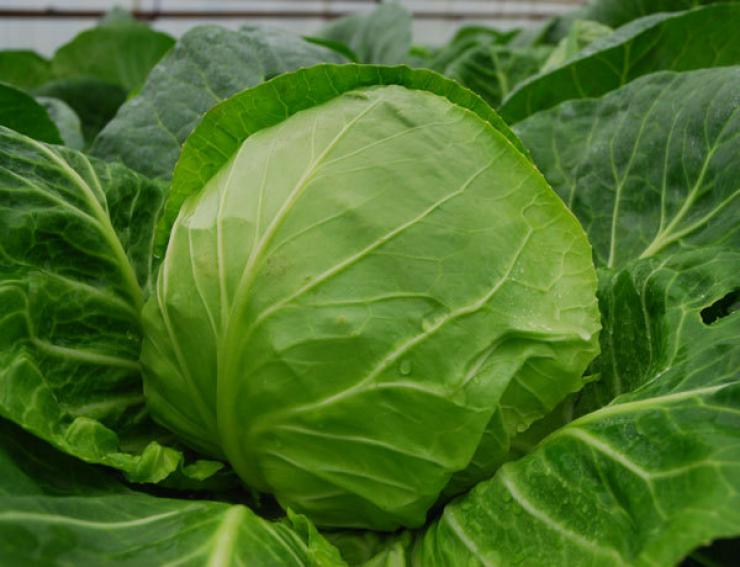

Description of varieties of white cabbage for Siberia
Among vegetable crops, cabbage occupies a leading place both in terms of sown area and production, and in terms of consumption. Here, in Siberia, cabbage is the main thing in the garden. It is not only tasty and nutritious, but since time immemorial it has been famous for its medicinal properties.
| In the West Siberian region, more than 45 varieties and hybrids have been zoned for both industrial production and for small farms and personal subsidiary plots |
The varieties loved by the people do not give up their positions:
- Belarusian 455,
- Sibiryachka 60,
- Present,
- Hope,
- Glory 1305,
- Number one Gribovsky 147,
- Point.
Along with them, more modern hybrids of domestic and foreign selection appeared.
In my selection, there is only a small fraction of what is zoned for the Siberian region. There are various options for creating the so-called. "Conveyor belt" so that you always have fresh, tasty, juicy cabbage on your table!
From this set, you can make the following selection:
- early,
- medium early,
- mid-season (salting),
- medium late (salting),
- storage.


Early varieties and hybrids of cabbage
| KazachokF1 |
This is one of the ultra-early cabbage hybrids of the Rice Research Institute and the S. N.N. Timofeeva. The hybrid is valued for its high yield, marketability, amicable formation of an early harvest, and resistance to cracking.
- Technical ripeness occurs 106–112 days after the emergence of full shoots or 40–45 days after planting the seedlings in the ground.
- The plant is compact, round head of cabbage, weighing 0.8–1.2 kg.
- The density of the head is good, the fresh taste is excellent.
Cossack F1 is relatively resistant to mucous and vascular bacteriosis, slightly damaged by cruciferous flea beetles.
| KevinF1 |
Ultra-ripe hybrid of Syngenta Seeds cabbage (Netherlands). Recommended for fresh use.
- The head of cabbage is round, covered, yellowish in section.
- The outer stump is short, the inner one is of medium length.
- The mass of a head of cabbage is 1.2–1.5 kg. The taste is great.
The value of the hybrid is early maturity, amicable return of the crop at an early date, high marketability, good transportability, resistance to cracking
| June |
This early variety of cabbage selection by VNIISSOK has long been known among vegetable growers. The variety can be planted at the earliest possible date, since it successfully tolerates frosts down to -4 ° C. Maturation of heads of cabbage is amicable.
- Within a couple of months after planting seedlings in the ground, it forms a good harvest.
- Heads of cabbage are round, medium density.
- The outer color is pale green with a slight waxy coating.
- Weight 0.9–2.4 kg, excellent taste.
The disadvantage of this variety is its poor resistance to head cracking.
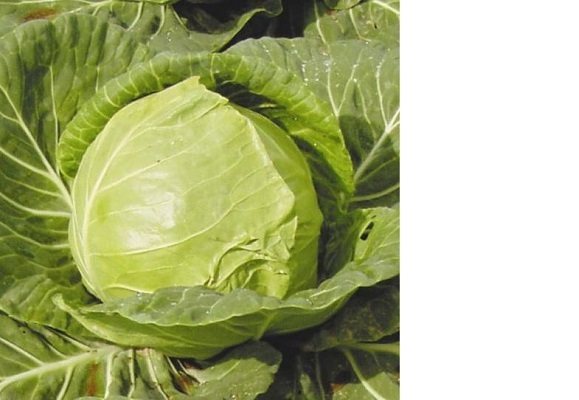

Photo: early variety of June cabbage
| Artost F1 |
Bejo Zaden (Netherlands). This mid-early cabbage hybrid is recommended for fresh use.
- The head of cabbage is round, covered, whitish in cross-section.
- The outer stump is short, the inner one is of medium length.
- The mass of a dense head of cabbage is 1.5–3 kg. Good taste.
- It retains its presentation well on the vine, does not crack, and is heat-resistant.
The value of the hybrid is high yield, resistance to vascular bacteriosis, transportability.
| Invento F1 |
Bejo Zaden (Netherlands). A mid-early hybrid of cabbage, recommended for fresh use.
- The head of cabbage is round, partially covered, whitish in cross section. Very tight.
- The outer and inner stumps are short.
- Head of cabbage weight 1.4–1.6 kg. Taste qualities are good and excellent.
The hybrid is resistant to cracking. Invento F1 is valued for its early maturity, amicable return of an early harvest, transportability, resistance to vascular bacteriosis and fusarium.
| TransferF1 |
High-yielding, early ripening hybrid of cabbage Research Institute of Rice and Breeding Station. N.N. Timofeeva. The value of the hybrid is fast growth, friendly crop formation, excellent taste, tolerates cold spring well.
- The period from planting seedlings to harvesting heads of cabbage is 60–70 days.
- Heads of cabbage are round, rather dense, weighing 0.9-1.3 kg, excellent taste.
Its disadvantage is the tendency to cracking the heads of cabbage.
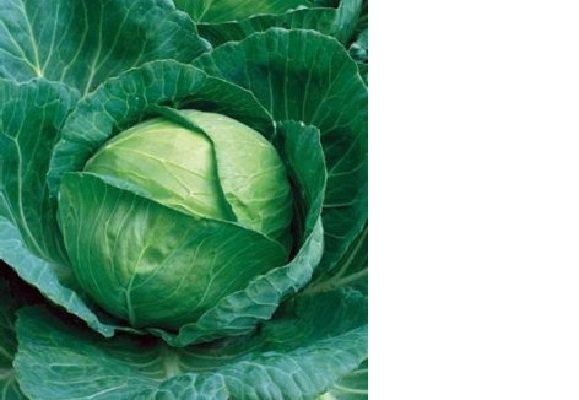

Photo: early cabbage hybrid Transfer F1
Medium early varieties and hybrids of cabbage
Among mid-early cultivars, two hybrids of Dutch origin can be distinguished - Bejo Zaden (Netherlands).
Rotunda
F1
The rosette of leaves is raised. Leaf of medium size, to large, gray-green, with a waxy bloom of medium intensity, slightly bubbly, slightly wavy along the edge.
- The head of cabbage of this hybrid is rounded, covered, whitish in section.
- The outer stump is of medium length, the inner one is of medium length, up to long.
- The average weight of a head of cabbage is 2.7 kg, density is 4.8 points.
The hybrid is resistant to vascular and mucous bacteriosis. Used for fresh consumption and storage for 3-4 months Bronco
F1
A versatile hybrid with powerful growth vigor.
- Heads of cabbage weighing 2.5–3 kg have an excellent dense internal structure and a short stump.
- The hybrid is very plastic, withstands soil and air drought, and retains its presentation in the field for a long time.
- The taste is excellent both fresh and fermented.
Does not crack, keeps well for 5-6 months.
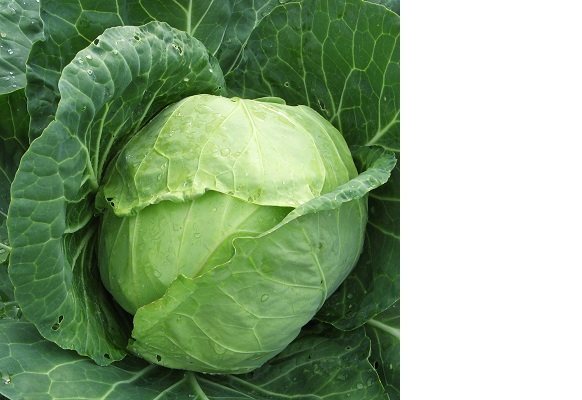

Photo: medium ripe cabbage variety Gift
Mid-season varieties and hybrids of cabbage
Tobia
F1
Seminis vegetable seeds SVS (Netherlands). Mid-season cabbage hybrid. Highly productive for processing. Ideal for fermentation. Heads of cabbage are dense, round-flat, dark green in color, with an average weight of 3.5–5 kg. The hydride is resistant to vascular and mucous bacteriosis, stands on the root for a long time, does not crack. Taste qualities of fresh and fermented products are excellent. Recommended for fresh consumption and processing. Semko Jubilee 217
F1
Art. them. Timofeeva (Moscow). This is a mid-season hybrid, unique in its properties, which is rightfully called the pride of Russian selection. The technical ripeness of the heads of cabbage occurs 130 days after full sprouting. The rosette of leaves is raised, medium-sized. Strong wax coating. The outer stump is 15–17 cm, the inner one is short. The head of cabbage is oval, half-covered, green, whitish on the cut, dense. The average weight of a head of cabbage is 3.5–4.5 kg. Fresh and sauerkraut tastes excellent. The hybrid is resistant to vascular bacteriosis, does not crack. Stores well for 4–5 months. Sat 3
F1(Glory 1305xBelarusian 455)
The hybrid is mid-season. From planting seedlings to harvesting cabbage, it takes 90-100 days. The head of cabbage is round, dense, weighing 3-4.5 kg. The outer color is light green, the inner is white-green. The inner and outer stumps are short. Fresh and sauerkraut tastes excellent. The hybrid is distinguished by high productivity and amicable ripening of heads aligned in shape. Resistant to causative agents of the main diseases of cabbage. The hybrid is appreciated for its high yield and excellent taste. Rinda
F.
Monsanto (Netherlands). A high-yielding cabbage hybrid that ripens 80 days after transplanting. The plant has a compact structure with slightly spreading covering leaves. A head of cabbage is round in shape, with a thin and dense structure. It can be stored for a long time in the field without cracking. Heads weight from 4 to 8 kg. It is used for fermentation, as well as for fresh consumption. Susceptible to vascular bacteriosis. Requires compliance with crop rotation. The value of the hybrid is high yield, morphological uniformity of plants, amicable crop formation, high density of the head of cabbage, suitability for fermentation.
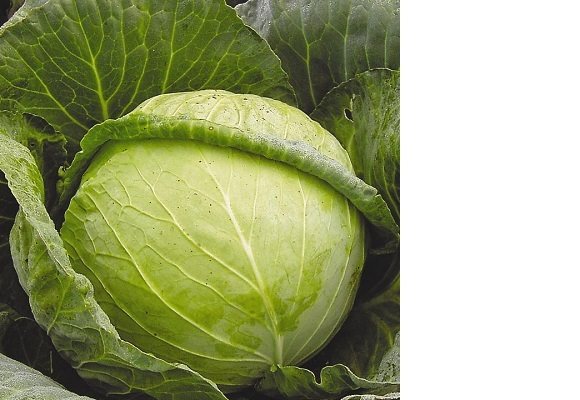

Photo: mid-season pickling variety Slava
Mid-late varieties and hybrids of cabbage
Thomas
F1
Bejo Zaden (Netherlands). Medium late cabbage hybrid. The period from full sprouting to the beginning of technical ripeness is up to 165 days. Heads of cabbage are medium in size, dense, weighing 2.1–2.2 kg. Used for fresh consumption and processing. The taste is good and excellent. The hybrid is resistant to fusarium wilt, does not crack. The output of marketable products is up to 95%. Megaton
F1
Bejo Zaden (Netherlands). It is an extremely productive hybrid of medium late ripening cabbage. The most productive hybrid among similar varieties of white cabbage. The period from full sprouting to the beginning of technical ripeness of the heads of cabbage is 100–105 days. Heads of cabbage are rounded-flattened, with a thin internal structure, have a short internal stump, smooth, very dense. The average weight of a head of cabbage is 8–10 kg, the weight of some individuals reaches up to 15 kg. Heads of cabbage for universal use: suitable for fresh consumption and various types of processing, can be stored for up to 4–5 months. The hybrid is resistant to fusarium. Devotor F1
Syngenta Seeds (Netherlands). Medium late cabbage hybrid. The rosette of leaves is raised.The leaf is large, gray-green with a strong waxy bloom, bubbly, slightly wavy along the edge. The head of cabbage is round, covered, whitish in cross-section. The outer stump is of medium length, the inner one is of medium length, up to long. Head of cabbage weight 2.2-3.7 kg, density 4.6 points. The taste is good and excellent. The hybrid is fruitful, with a high yield of marketable products, good and excellent taste, resistant to damage by vascular, mucous bacteriosis and fusarium. Florin
(West Siberian Experimental Station) Medium late cabbage hybrid. The technical ripeness of the heads of cabbage occurs 140-145 days after full sprouting. The rosette of leaves is half-raised. The leaf is gray-green with a medium waxy bloom. The head of cabbage is round-flat, dense, partially covered. The mass of a head of cabbage is 2.3–4.5 kg. Good taste. The harvest is high, the output of marketable products is 91–99%. Weakly affected by white rot, vascular and mucous bacteriosis. The variety is characterized by high yield and marketability, good ripening, high density, versatility of use, suitability for storage.


Photo: medium late variety of Belarusian cabbage
Late varieties and hybrids of cabbage
Gingerbread man
F1
Art. them. Timofeeva (Moscow) Late-ripening hybrid of cabbage. The technical ripeness of the heads of cabbage occurs 144-155 days after full sprouting. The head of cabbage is round, 16–20 cm high, weighing 4.2 kg. The outer color of the head is green, white on the cut. Fresh taste is excellent. Recommended for fresh consumption, fermentation and long-term winter storage. Hybrid value –
high morphological uniformity of plants, amicable formation of the yield, excellent density of the head of cabbage and keeping quality for 6-7 months, high marketable yield. Gingerbread man F1 is resistant to vascular and mucous bacteriosis.
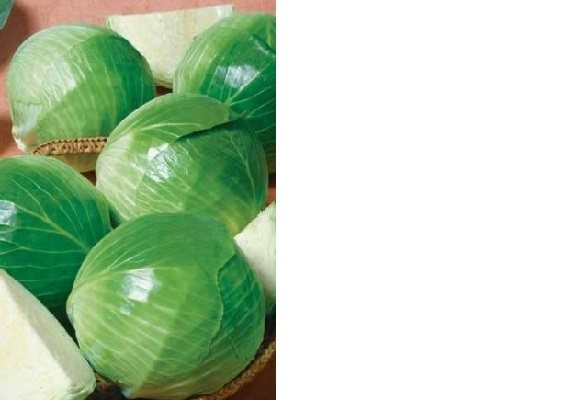

Photo: a productive late-ripening hybrid of cabbage for storage Kolobok F1 Valentine
F1
Art. them. Timofeeva (Moscow). One of the best late-ripening cabbage hybrids intended for fresh consumption in the winter-spring period after winter storage (8 months). Even after such a long storage, the heads of cabbage do not lose their taste and color. Heads ripen in 140–150 days. Heads of cabbage are oval-rounded, dense, weighing up to 3 kg, with a short internal stump and white color on the cut. Hybrid Valentine F1 is resistant to vascular, mucous bacteriosis, fusarium. Prestige
F1
Art. them. Timofeeva (Moscow). Late ripe cabbage hybrid. The rosette of leaves is raised. Medium-sized leaf with a strong waxy coating. The head of cabbage is round, covered, whitish on a cut, dense, weighing 2–3 kg. The taste is good. The output of marketable products is 94%. Leveled heads of cabbage. The hybrid is resistant to fusarium wilt. Extra
F1
Art. them. Timofeeva (Moscow). Late ripe cabbage hybrid. Ripens in 155-170 days after full germination. Heads of cabbage are flat-round, with a strong waxy bloom, very dense, weighing 2.5–3 kg. They are perfectly stored until May without loss of taste. The hybrid is resistant to vascular and mucous bacteriosis, gray rot, fusarium wilt.
Which variety is better for pickling and pickling
Late varieties are ideal for fermentation. True, a mid-season culture can be used for salting. The cabbage recommended for pickling ripens for 120-150 days. She should have a dense, not cracked head of cabbage, sweetish taste.
Glory 1305
This is the most ideal variety for fermentation. It can be grown in any region. True, heads of cabbage are not stored for a long time (only until January). Seedlings at a young age are exposed to diseases (black leg). Heads of cabbage often crack when ripe. Harvesting is desirable after the first frost. Heads of cabbage become sweeter, do not taste bitter. The average weight of vegetables is 3-5 kilograms. Ripe heads of cabbage have a pleasant greenish color. Inside there are white leaves.
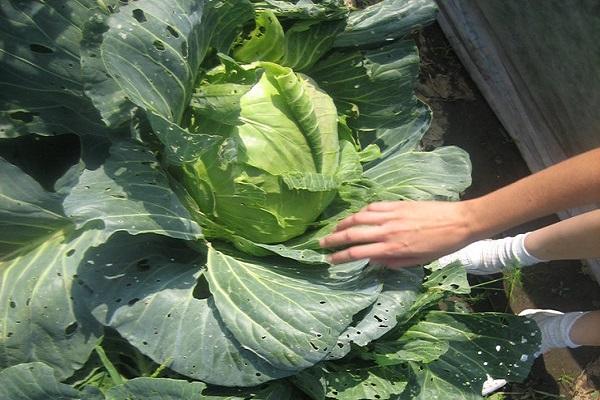

Belarusian
Bred in 1937, it is resistant to frost and many diseases. Vegetables can be grown in northern latitudes. It is better to harvest after the first frost. Late harvested cabbage is sweeter, less bitter. Ripe vegetables are plump, pale green in color. The mass of one is about 3-4 kilograms. The heads do not crack during growth, they tolerate drought well. Sauerkraut is very tasty when cooked. It can be stored raw, but no more than 3 months.
Present
Cabbage ripens in late August and early September. A medium-sized leaf rosette is slightly raised. Ripe vegetables are plump, round, greenish-white in section. The mass of one vegetable is 2.5-4.5 kilograms. In a cool room, cabbage can be stored until March. Vegetables are suitable for pickling and preparing fresh vegetable salads.
Valentine F1
Hybrid late culture. The plant has a raised rosette, medium-sized leaves. The ripe vegetable is round, plump, white in section. The mass of one is 3-4 kilograms. The harvested cabbage is stored for 7 months. The heads are juicy and sweet. Ideal for fermentation. Does not crack, rarely get sick, does not rot.
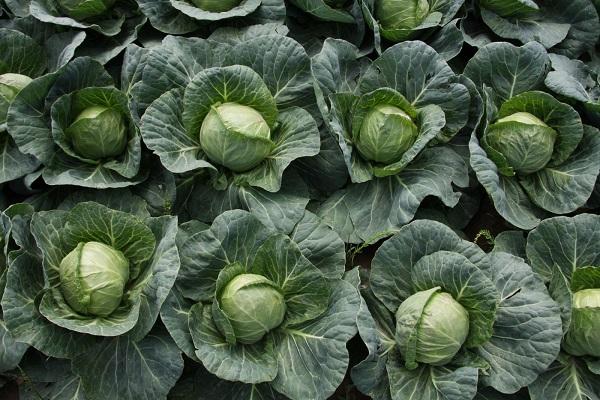

Features of cultivation in Siberia
Planting cabbage in open ground with seedlings according to the lunar calendar
To grow cabbage in the conditions under consideration, you must first of all choose a winter-hardy and adaptive variety. For Siberia, you need to use the best varieties of cabbage. It should be noted that white cabbage is the most common in this area, as well as other varieties of this culture:
- redhead;
- savoy;
- kohlrabi;
- colored;
- Brussels;
- Beijing.
Usually the culture is planted with seedlings, but planting seeds in open ground in early spring is also successfully used. The best precursors for cabbage in Siberia are beets, potatoes, and onions. As the cabbage grows, the soil is weeded, it is imperative to thin out the sprouts by 4-5 cm. Further care of the crop is almost completely similar to what is carried out in the European part of Russia.
If you comply with all the requirements described above, then it will not be difficult for a Siberian gardener to grow such an unpretentious crop as cabbage, and a rich harvest of cabbage will not take long!
Recommended varieties for long-term storage for the winter
Winter varieties ripen 150-180 days after sowing the seeds. These crops have excellent long-term storage properties. The leaves of vegetables are tough, not very sweet. Some varieties (Amagera) have a bitter taste. For long-term storage, late, sometimes mid-season crops are grown.
Hybrid vegetables, Dutch varieties and some domestic varieties (Bartolo F1, Atria F1, Zimovka 1474) are best stored.
Glory
The culture is mid-season, resistant to many diseases. The head is pale green, white on the cut. The mass of one vegetable is about 4 kilograms. The harvested crop can lie until the new year. The variety is ideal for fermentation.


Kharkov winter
Late culture, does not crack. It tolerates frost perfectly, which is obvious from its name. Ripe vegetables are plump, round, green on top, white on the inside. The mass of one is 1.95-3.55 kilograms. Heads of cabbage rarely get sick, do not rot, and can be stored until spring.
Geneva F1
Heads of cabbage do not crack, are stored for up to 6 months, rarely get sick, do not rot. This is a late culture, it tolerates the first frosts well. The head of cabbage is plump, white in section. The mass of one vegetable is about 3 kilograms. Cabbage is pickled, fermented, canned, salads and vegetable dishes are made.
Are all suitable for long-term fresh storage?
When choosing cabbage seeds, it is worth remembering: early varieties with very delicate, tasty leaves are not suitable for long-term storage.
In order to enjoy cabbage dishes all winter, it is worth choosing late or hybrid varieties.


They are characterized by the following characteristics:
- a high indicator of resistance to negative weather conditions;
- high yield percentage;
- disease and pest resistance;
- heads of cabbage are dense and large (weight up to 6-7 kg);
- the taste of the leaves may improve during storage;
- the growing season is from 110 to 180 days.
The most popular varieties of Dutch cabbage
Dutch cabbage has a good yield. Many varieties of the Dutch selection are resistant to disease. They grow well in a temperate continental climate, they tolerate the first frosts well.
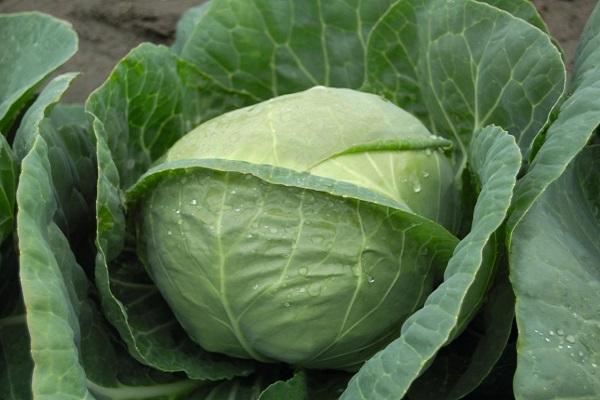

Bronco
Dutch hybrid with large, juicy, dense heads. Cabbage is eaten fresh and fermented. The mass of one vegetable is 4 kilograms. The culture is mid-season. Vegetables rarely get sick with bacteriosis. The harvested crop can be stored all winter.
Cubton
Fusarium resistant hybrid. Vegetables ripen even in hot and dry summers. Cabbage collected from the garden is stored until the new year. She has plump, white heads of cabbage inside. The mass of one vegetable is 2-4 kilograms. Cabbage is suitable for pickling and fresh consumption.
Mehndi
A plant with perfect round heads, very sweet and juicy. Can be stored in a cool place for almost 6 months. Not afraid of drought. Ripe vegetables have light green outer leaves, white cabbage inside. The mass of one vegetable is up to 5 kilograms.


Recommended mid-season cauliflowers
Gingerbread man
Polish cauliflower "Flora Blanca" - a real decoration of the beds
I read somewhere how a woman shared “I remember my mother’s words - wrap the tip of the root around the cabbage” - When planting seedlings, pinch the central root of each plant so that it can be tied better! With his fingers he feels thicker than others.
Protection from pests. This plant can be affected by very different pests, which are quite difficult to deal with. However, for prevention, it is quite effective to use folk remedies: dusting of cauliflower with wood ash or tobacco; spraying with infusions of onion husks, burdock or tomato stems.About whatThe resulting crop can be stored well for a long time.
Hybrid variety:
The variety has a high resistance to cauliflower diseases.Growing cauliflower in your own garden is a little more difficult than the usual white cabbage.Medium early varieties and hybridsSmooth F1
In addition to the above, the varietal catalog published by the Timiryazev Academy in the form of practical advice for gardeners in central Russia recommends using the following varieties and hybrids for storage:.
- - And I have been planting Bronco cabbage for the second year. The kachan is not very big in appearance, but so dense! In the spring, already brushed, weighed 4.5 kg. Stored well, juicy and tasty.
- To prevent cabbage from being affected by various diseases, it is very important to alternate crops in the beds.
- Merits
This cauliflower is not afraid of autumn frosts and is resistant to bacteriosis.
Mid-season cauliflower "White Beauty": features and advantages
Cabbage tastes good and can be used both fresh and canned.
Easily adaptable and tolerates bad weather conditions.
After all, this type of cabbage is not so stable and more demanding to care for. However, its taste, high vitamin content and beneficial properties make cauliflower simply irreplaceable for the diet of both children and adults.
(126-135 days): Warranty, Domestic, Moscow canning, Snowdrift, Icing sugar, Purple, Celeste, Regent MS.
- late ripening, moderately susceptible to gray rot, keel, vascular and mucous bacteriosis, as well as damage by cabbage fly; has a stable yield;-
- For the Urals and Siberia, experts recommend long-stored varieties
- - Late cabbage SeDeK - Valentina, and SEMKO - Lennox pleased already in the garden
- Fertilizing beds and feeding plants. Soil fertility is a very important aspect of the growth of cauliflower. Before planting it, the soil is dug up and a large amount of organic matter is introduced into it. Subsequently, to stimulate growth, plants are poured with solutions from mullein or chicken droppings. Certain varieties also require mineral fertilizers.
- Hybrid worth mentioning yet?
The cons of growing this cauliflower variety have not been identified.
High-yielding hybrids
Agricultural firms mainly grow hybrids that rarely get sick, do not die, do not rot, and can give a good harvest. Such crops are well adapted to temperate weather conditions. Vegetables are stored for a long time, during storage they do not lose their taste.
Centurion
A hybrid that, with proper agricultural technology, gives a high yield. A mature vegetable has a plump structure, a short inner stump. In the context, the heads of cabbage are white, homogeneous. The growing season of this culture is 110 days. The weight of a mature head is 3.5 kilograms. The fruits ripen together, are used for salting and preparing salads, vegetable dishes.
Foreman
A hybrid culture with a snow-white, compact head of cabbage. Medium late cabbage, ripens on 120 days. The mass of one vegetable is up to 5 kilograms. The cabbage is juicy, sweet, suitable for pickling and making fresh salads. The culture is best grown in seedlings.
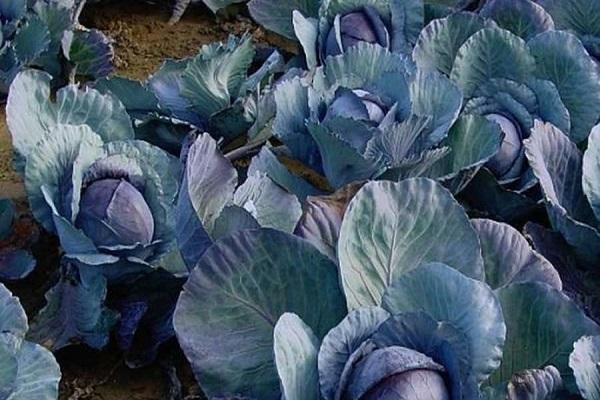

Gintama
A hybrid crop that can grow on any soil. The outer leaves are huge, grayish-green, covered with a waxy bloom. Inside, the head is white, plump. The mass of one vegetable is up to 4 kilograms. The culture rarely suffers from fusarium and bacteriosis. Can be stored for a long time. Suitable for fermentation and preparation of vegetable dishes.
New varieties of red cabbage
Red cabbage is the closest relative of white cabbage. New hybrid vegetables have a very fast ripening period of only 80-90 days. Some varieties of red cabbage do not taste bitter, they are not too sour, and are great for pickling and preparing fresh salads.
See also
Description of late varieties of cabbage Sugarloaf, Kolobok, Atria, Valentina and othersRead
Kalibos
A very beautiful variety with an oblong head of cabbage. The mass of one vegetable is 2.5 kilograms. The inside of the cabbage is not very dense. The leaves are tender and juicy. Cabbage ripens late, 150 days after planting. It is not stored for long, quickly deteriorates. This is the most delicious variety of red cabbage.


Example
Dutch early maturing hybrid. Ripe vegetables are round, dense, juicy, without bitterness. The mass of one is 2 kilograms. The culture is well stored, it tolerates transportation well. Cabbage is ideal for sale.
Landing rules
All late varieties of white cabbage or cauliflower are planted in early May. To do this, on the 10th of March, the seeds are planted in containers, they are allowed to germinate.
It is best to treat seeds with disinfectants: oxychom or manganese solution. The optimal dose of drugs is 10 mg per 10 liters of water. This is necessary to reduce the risk of influencing the culture of parasites and diseases. The first shoots, subject to the correct temperature regime, appear after 40-50 days.
For the first 2 weeks, a container with seeds of late-ripening species is kept at a temperature of 25-28 ° C. After 14 days, the temperature regime should depend on the time of day: the daytime temperature is about 18 ° С, and the nighttime temperature is 8-10 ° С. This allows the plant to quickly acclimate to the environment after being planted outdoors.
2 weeks before planting in open ground, the seedlings are hardened. To do this, they are taken out into the street every day. In the fresh air for the first few days they are kept for about 2-3 hours, after which the airing time is gradually increased to 8 hours.
Only fertile lands are chosen for planting. It is best if the soil acidity level is no more than 4%. Otherwise, the growth of seedlings will slow down, and the yield will decrease. The optimal planting scheme for late varieties of white cabbage is 70 x 80 cm. The planting depth should be such that the lower leaves of the plant are above the ground.
Late-ripening varieties of Dutch cabbage need full care:
- Watering is done once a week and only with warm water (this increases the adhesion of the roots to the ground). The optimal amount of water is 2 liters per 1 bush.
- Top dressing is carried out using mineral and organic fertilizers. The first - 14 days after planting in open ground. It consists in the use of organic matter: humus or poultry droppings (about 3 kg per 1 sq. M). During the second feeding, during the flowering period, nitrogen and potassium compounds are used (10 mg of ammonium nitrate, 20 kg of potassium nitrate per 1 sq. M). The third top dressing, carried out at the beginning of fruiting, involves the use of phosphorus fertilizers (40 mg of superphosphate per 10 liters of water). The beds are watered with this solution.
- The soil is loosened, weeds are removed. A crust must not be allowed to form on the ground. Weeding depth should not be more than 6 cm, otherwise there is a risk of damage to the root system.
Recommended for growing in Siberia and the Urals
In summer, cabbage has been cultivated in northern latitudes since time immemorial. New varieties specially bred for this region tolerate frosts well, rarely get sick, grow quickly, and give a friendly ripening.
Junior F1
Hybrid crop with excellent frost resistance. The cabbage rosette is slightly raised. A ripe vegetable has a white center. The head of cabbage is plump. The mass of the vegetable is 2 kilograms. The culture is medium early. It is advisable to use it for preparing salads.
Arctic F1
Hybrid cabbage with an early ripening period. Vegetables ripen 45 days after planting the seedlings. Round heads weigh 1.5 kilograms. Frost-resistant culture with sweet juicy heads of cabbage.


Florin
The culture is medium late. Grown for fermentation and preparation of fresh salads. Ripe heads are round, with a plump structure, white in section. The mass of one vegetable is 3-4 kilograms. The culture does not crack, rarely gets sick. Plucked vegetables can be stored for 7 months.
Sibiryachka 60
A variety bred for Siberia. The culture is resistant to low temperatures. Ripens 140 days after the first shoots appear. The heads do not crack, after harvest they are stored without spoiling for almost 4 months. The average weight of one vegetable is 4 kilograms. The head is plump and white on the cut. The variety can be fermented for the winter or fresh salads can be prepared.
Orion F1
Late ripening hybrid. Heads of cabbage ripen on day 160. The culture loves sandy loam or loamy soil. The plant has a compact, vertically growing rosette. The head is round, plump, weighing 2.3 kilograms. Heads of cabbage do not crack, rarely get sick with bacteriosis and fusarium wilt.
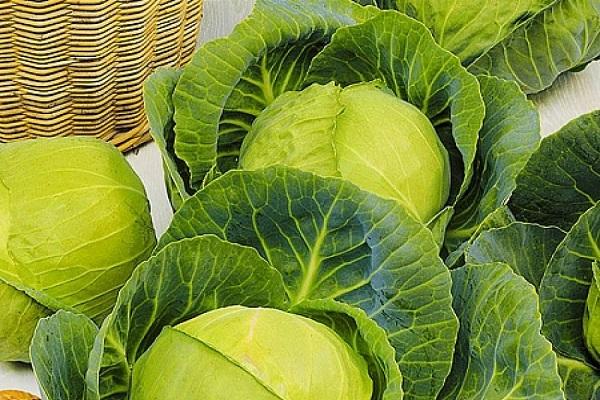

Early ripening
An early maturing crop, bred back in 1973. Cabbage ripens 55 days after planting the seedlings. Cabbage rosette is shallow, with raised leaves. The mass of one vegetable is 1.3 kilograms. Cabbage often cracks. Grown for making fresh salads.
Polar K-206
The variety was bred back in 1950. This is a mid-early culture. Grown for fresh consumption and salting. Cabbage rosettes are medium, 80 centimeters in diameter. Heads of cabbage are round, medium-sized, dense and uniform in the middle. Heads of cabbage can crack, get sick with keel, bacteriosis.
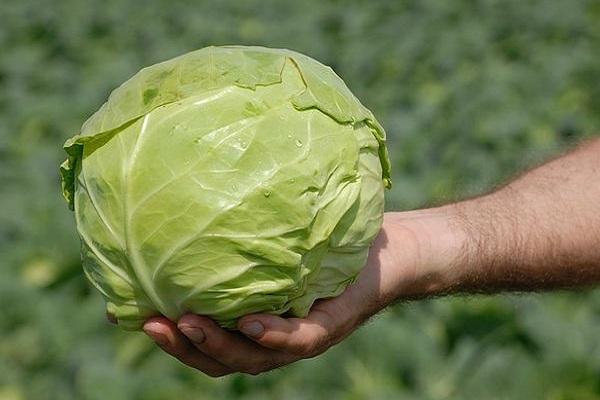

Features of growing and harvesting
When harvesting cabbage for long-term storage it is important to adhere to the rules of its cultivation and collection of ripe vegetables:
- It is best to plant cabbage in an area where peas, cucumbers, tomatoes, and carrots grew before.After corn, a good harvest cannot be expected.
- Light or loamy soil is optimal. Heads of cabbage grown on sandy loam soil are not stored for so long.
- Fertilizers can both prolong and reduce the shelf life of cabbage. Phosphorus-potassium dressing will increase the storage time. Cabbage grown on nitrogen-rich soil will quickly deteriorate: the amount of dry matter in its foliage is reduced, which is why the leaves are prone to rotting.
- Harvest when the daytime temperature is at + 2 ... + 8 ° C, and at night there are frosts down to -3 ° C. Heads of cabbage collected earlier quickly begin to wither.
- Vegetables are harvested in dry weather so that they do not have to be dried additionally. The forks are cut with a sharp knife, leaving 2-3 cm of stumps. For storage in a suspended state, the stumps are left.
- The top sheets are not removed, leaving at least 2-3 cover sheets, which will protect the cabbage from diseases and mechanical damage.
- Before wintering, the heads of cabbage are sorted: only whole specimens are left, without signs of lethargy, rot, diseases or the presence of pests. Vegetables of medium size, tight and round, slightly flattened are best suited. Loose heads of cabbage are unsuitable for storage.
It can be useful:
How to make a storage box for potatoes on the balcony
Features of storing carrots at home
Recommendations: how to keep onions at home
Nuances for different regions
Climatic conditions at different latitudes are very different from each other, therefore each region has its own characteristics of agricultural technology.
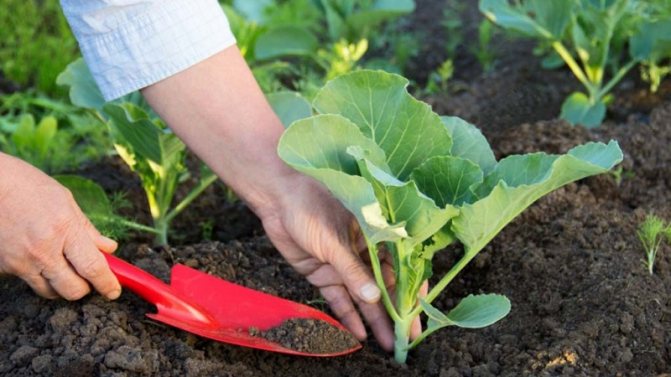

In outskirts of Moscow
The predominance of cloudy days and erratic spring weather create difficulties in the early stages of crop cultivation. To achieve a good harvest, some features are taken into account.:
- cabbage is planted in open ground with seeds, seedlings are covered until the onset of stable warm weather;
- choose mid-ripening or mid-late varieties, since the late ones will not have time to ripen;
- in the absence of precipitation in summer, plantings are regularly watered.
In Siberia
Harsh climatic conditions exclude the cultivation of cabbage in the open field from seeds, therefore, the seedling method is used.
Attention! Due to the short summer, it is better to refuse to plant late varieties with a long growing season. Mid-season and mid-late plants are preferred.
Specially varieties adapted to the harsh climate: Sibiryachka 60, Blizzard, Nadezhda, Tochka.
Seedlings are planted in open ground in the second half of May, at first, the beds are covered. In August, mid-season cabbage is harvested for fresh consumption or pickling. Medium late vegetables are harvested in September.
In the Urals
The unstable Ural climate is characterized by sharp changes in temperature and intense movement of air masses:
- seedlings are grown in warm beds, in greenhouses or at home;
- in May, plants are planted in open ground, the site is covered with dense spunbond: it will protect the crop from pests and low temperatures;
- to protect against a cold snap, the beds are mulched with black film.
Varieties grow well in the region Hope and Blizzard, hybrids Atria, Aggressor, Megaton.
In the middle lane
The middle zone is characterized by a temperate continental climate with humid summers and moderately frosty winters. Here cabbage is grown in seedlings.... Optimal planting of late-ripening hybrids, the ripening period of which is from 160 to 170 days.
Which cabbage is better to plant in Central Russia
In this region, specially bred varieties are grown that are resistant to drought, frost, and many diseases. Planting method - seedling or seedling.
Number One Gribovsky 147
The variety was bred back in 1940. The crop ripens early, 100 days after planting. Cabbage rosette is slightly raised, compact. The heads are not very dense, weighing about 2 kilograms.Ripe cabbage is not stored for long, rots quickly, it is grown for making light vegetable salads. The culture tolerates drought and low temperatures well.
Transfer F1
Hybrid, early ripening culture. The shape of the head is round, the weight of one vegetable is 1.5 kilograms. It is advisable to eat cabbage fresh. The hybrid almost does not suffer from bacteriosis and black leg.
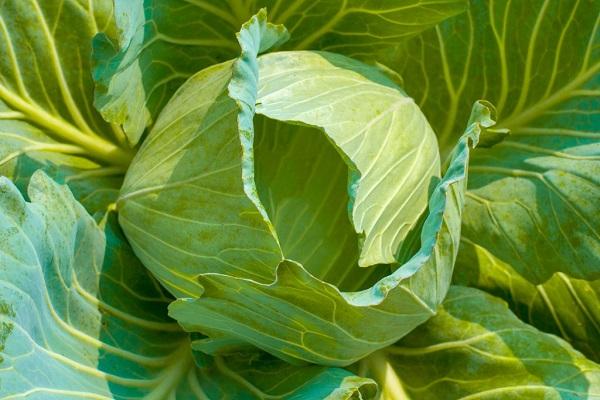

Kazachok
An early ripening hybrid bred by Russian breeders. Crop can be harvested 95 days after planting. Cabbage has plump, round heads, weighing 1.2 kilograms. The culture does not like acidic soils; it grows well on loams.
Cabbage does not tolerate heat and shade. The variety is not resistant to frost. It is advisable to plant cabbage in seedlings.
Golden hectare 1432
Mid-early culture. Ripens 100 days after germination. The upper leaves are smooth, gray-green. The heads are round, flat, of medium size. The weight of one vegetable is up to 3 kilograms. The culture rarely gets sick, tolerates night frosts well.
The most famous late varieties of cauliflower
Heat and cold resistance is high.
Produces good yields in very short periods.
Cortez F1 - the highest yielding late cauliflower
Moreover, for fans of gardening, it will be very interesting to master the procedure for growing a new plant.Mid-late varieties and hybrids-Albatross F1Geneva
- A neighbor has been planting KORONET cabbage for 2 years, awesome cabbage!
Pinning cauliflower seedlings. As mentioned above, stabbing should be started already from the 12th day of seedling growth in order to help it better adapt to open air and exposure to sunlight. It is worth taking out boxes with seedlings outside only in the daytime. When growing it under a film, the latter simply rises for a day.
This hybrid has such an ability as the "self-covering" of the head with leaves in the hot summer period, which protects it from damage by the sun's rays.
The very head of this cabbage has a white color and a very dense structure. The shape is round. The weight of one head on average can have indicators of 1.2 kilograms.Allows you to get up to 2 harvests in one season.In fact, it is very difficult to name any disadvantages of this variety, which became clear after listing all the advantages.
- But today we will talk not so much about agricultural technology and the peculiarities of caring for this crop, but about its best varieties.
- (146-159 days): Universal.
Latima F1
Hybrid form of late cauliflower "Amerigo F1" - how popular is it?
- late ripening cabbage hybrid resistant to black leg, vascular and mucous bacteriosis; suitable for mechanized processing;
,
- Cabbage Kharkiv winter, Kolobok, Snow White, Turquoise, Yaroslavna, but last year I tried Aggressor - I liked it much more. I plant seeds right in the garden in the hole, in the summer I weed and harvest in the fall.TIP:. I sowed cabbage for seedlings in the snow, covered it with plastic wrap. The snow melted. I opened it during the day, covered it at night. It was a normal seedling.High productivity.
The leaves are light green, almost completely covering the head. Deserves special attention due to its taste and high content of minerals.
When sowing seeds for seedlings at the same time, adult plants ripen at the same time.The only thing that confuses many isWe will try to acquaint you with varieties of different growing periods, so that you can definitely choose the right one for yourself.
- Late-ripening varieties and hybrids
- - late ripening, has leveled small portioned heads of cabbage; has good transportability;
-
What to choose for the southern regions
For southern latitudes, it is advisable to select varieties that tolerate drought well and do not require frequent and abundant watering.In this region, cabbage can be grown in a seedless way.


Zavadovskaya
Late ripening culture. The head is dense, round, does not crack. The head of cabbage is green from above, in cross-section its center is white. The weight of one vegetable is 2.5-4 kilograms. The culture is suitable for fermentation. You can eat cabbage fresh.
Derbent local improved
An early ripening culture bred at the Derbent Experimental Station. Cabbage ripens in 109 days. The culture has a small rosette, only 0.7 meters in diameter. The outer leaves are dark green, with a slight waxy bloom. The heads are plump, white in section. The mass of one vegetable is 1.2 kilograms. It is advisable to consume the culture immediately after harvesting; it is poorly stored.
Judge 146
Southern variety, bred in 1950. The culture is medium late. It tolerates high temperatures perfectly. He rarely suffers from bacteriosis. Grown for fermentation and preparation of vegetable salads.
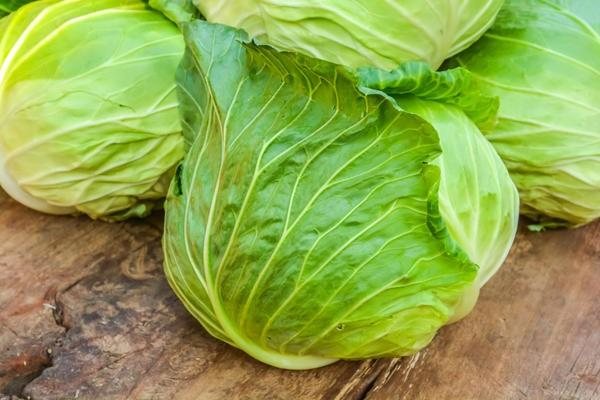

Mozharskaya local
Medium late crop, with medium sized heads of cabbage. The weight of vegetables is about 3 kilograms. The variety tolerates high temperatures well, but requires regular watering. The heads may crack. Grown for salting and fresh consumption.
What varieties to plant in open ground in the suburbs
In the Moscow region, the climate is moderately continental, summer is cool, spring frosts recede by mid-May, autumn ones appear in October. The crops grown in this region should be well tolerated by the vagaries of nature and mature before the beginning of October. The most popular varieties: Slava, Dumas, Valentina, Zarya, Aggressor, Crumont, Gift.


Dumas
Early ripening culture. Grows well in the shade, resistant to many diseases, including rot. The cabbage has a large and plump head. The mass of one vegetable is up to 4 kilograms. The culture is grown for the preparation of vegetable salads.

